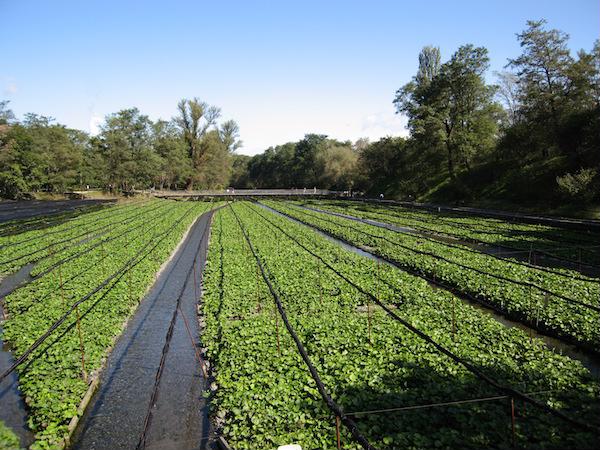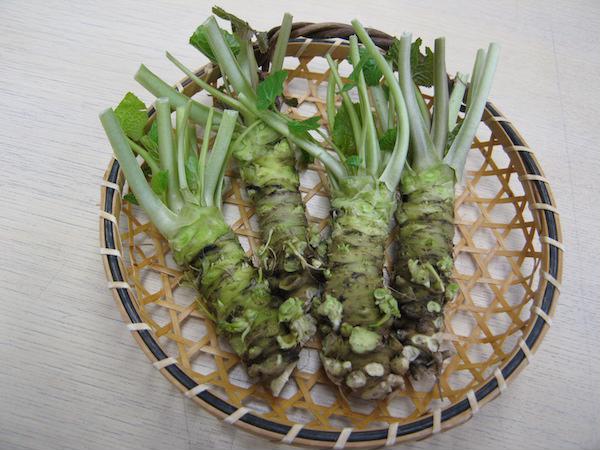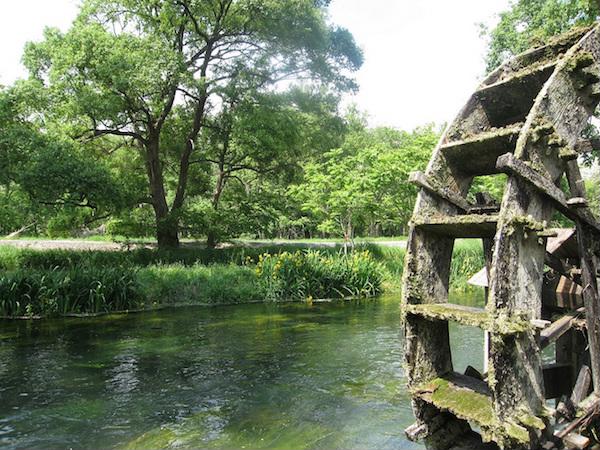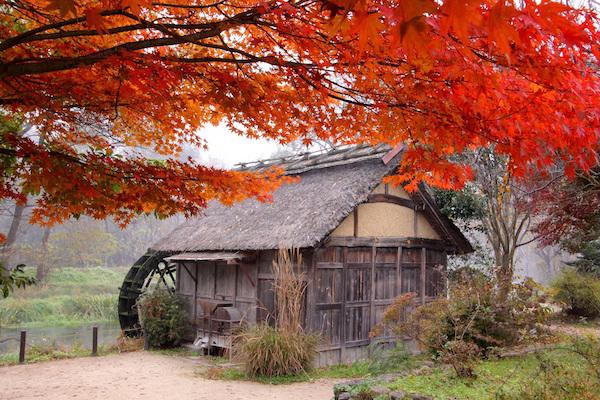Daio Wasabi Farm covers 15 hectares of land making it Japan’s largest wasabi farm, producing 130 tons of wasabi every year.
Established in 1917, it took around 20 years for it to become the farm that it is today.
What is wasabi?
Wasabi is a type of wild grass that is grown using a rich, clear stream.
When eaten, it has a sharp and exciting flavor.
If the water temperature rises too much while it is being grown, the growth of the plants will be hindered which is why it is primarily grown in the highlands and cooler climates.
The leaves, flowers and even parts of its roots can be eaten.
It is also used as a seasoning for sushi and sashimi and is an indispensable ingredient to Japanese cuisine.
At the Daio Wasabi Farm, wasabi is grown using up to 120 thousand tons of spring water from the Northern Alps each day.
This spring water is rich in minerals and because its temperature stays at around 13°C throughout the year, it is perfect for growing wasabi.
Nonetheless, the edible center of the plant known as the rhizome is slow to grow, taking about 1 – 2 years for the plant to reach a large size.
Because of this, it can be said that it is laborious crop and although it depends on the type of wasabi, it usually gets bigger the older it gets and so the price also increases.
It is said that 3 years is the longest time for a wasabi plant to be grown, but I have yet to see one.
Point of interest: The water wheel
As you pass the entrance, the Tadegawa river flows immediately to the left.
The sight of the water mill hut on that river is not to be missed by anyone who visits the farm.
With watergrass that moves with the flow of the river’s crystal clear water, as well as the mossy water wheel that turns slowly,
this is a truly beautiful sight that lets you lose your sense of time.
I have also been many times when shooting for a TV travel program, but there were too many places to focus on so it took a long time.
This water wheel was originally installed as a set for director Akira Kurosawa’s movie, "Dreams".
As expected, Kurosawa chose a great place to put it.
After the shooting finished, it was inherited by the farm and has been carefully preserved as part of the farm’s landscape.
The clear boat is also a good experience
Although it is not operated by the Daio Wasabi Farm, there is also a "clear boat" experience which sails along the Tadegawa river.
There is a green tent beside the Daio Wasabi Farm where visitors can register.
After rowing upstream, the rest is left up to the flow of the river until the boat reaches the water mill, when it is rowed a little back upstream.
The course takes about 20 minutes, and is a popular activity because you can see the beautiful river up close.
(12 years and above: ¥1200, 6 – 11: ¥900, below 5: ¥100)
See the wasabi making process
Inside there is also an area open all year round where visitors can see how harvested wasabi is processed.
Here you can watch how each part of the freshly picked wasabi is carefully separated.
Although visitors watch through a glass pane, the heat of the wasabi would sting your eyes so this is actually a good thing.
Wasabi pickling experience with souvenirs
Pickled wasabi is raw wasabi seasoned with salt which is kneaded with residual yeast left over from making sake, known as sake lees.
At meal times, this is added to bowls of rice.
If you eat this with white rice, you will be able to keep on eating as much as you want.
This is available as an experience at the Daio Wasabi Farm.
It is easy to make and simply involves chopping the wasabi, adding salt and kneading it with the sake lees.
Participants can take what they make home with them as a souvenir.
It should be eaten within 2 – 5 days after it has been made.
Time to allow: About 20 minutes
Price: ¥1030
Time: 10:00, 11:30, 13:00, 14:30
(Reservations to be made at least 2 days in advance)
Do not miss the wasabi menu!
There are restaurant and kiosk in the farm, so you can eat wasabi menus.
If you want to try something sweet, then there is wasabi ice cream for 360 yen.
Using the flavor of whole wasabi and the color of soft serve ice cream, a sweet and creamy taste is combined with the refreshing scent of wasabi to create a complicated flavor.
But, the flavor is not strong and there is no doubt that you will love it.
As for a meal, if you want to enjoy the taste of traditional wasabi then try the ‘Hon Wasabi Don’ for 720 yen.
This dish has seaweed, onions and white sesame seeds mixed in with hot rice, with grated wasabi and soy sauce on top of fragrant dried bonito.
It is a simple menu, but sometimes the simpler things are best if you like the flavor of the ingredients.
In truth, wasabi is hot. Even Japanese people are not immune to its heat.
But, that spiciness can help you feel refreshed.
Everyone should give it a go, maybe share a dish, and have fun watching all the different reactions!
When is the best time to visit?
-To see the wasabi plants
Either February to March, or October to November, are the best times to visit.
During hotter weather, the wasabi fields are covered from the sunshine so they cannot be seen.
-To see the water wheel
From when the fresh green leaves are out in May to when the autumn leaves turn color in November are good times to see the water wheel,
but the middle of summer can be said to be the best time, as the green is darker and helps visitors to feel cool.
The secret recommendation of the staff on the farm is to go on a winter morning, as the scenery is especially beautiful after snow has fallen.
Next time I also plan to go in winter.
To take photos of the water wheel and the flowing river, it is most beautiful in the early morning.
 JAPAN Travel Concierge
JAPAN Travel Concierge


